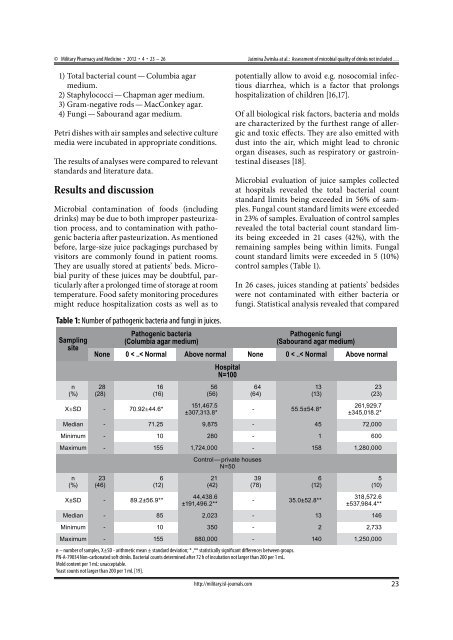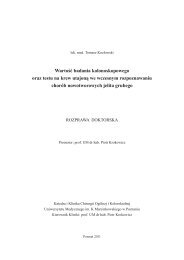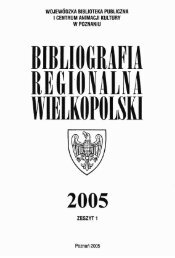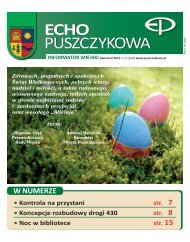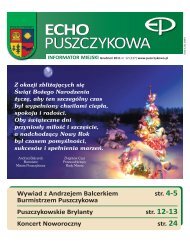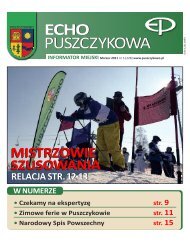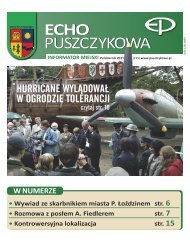© Military Pharmacy and Medicine • 2012 • 4 • 22 – 26be not only due to patient-to-patient transmission,but also to the consumption of food ofpoor microbial quality. The threat may originatemainly from products brought to patientsby visitors [1]. It is common for the visitors tobring drinks in large packagings, both cartonand plastic bottles. Patients, particularly childrenand the elderly, have difficulties usingsuch packagings. This also pertains to patientswho cannot move easily after procedures theyunderwent. With water consumption recommendationssuggesting that a single servingshould not exceed ca. 100 mL (in adults), depletionof a 1.5 L, or sometimes even a 2 L takes asignificant amount of time [4]. This poses a significantthreat of microbial infection with bacteria,fungi and molds present in the hospitalenvironment [5].Currently, there are no standards definingacceptable levels of airborne microorganismsin indoor air (hospital facilities) in Poland TheOrdinance of the Minister of Health of 26 June2012 on detailed requirements for the facilitiesand equipments in entities engaged in medicalactivities, being the executive act for the Actof 15 April 2011 on medical activities (Journal ofLaws of 2011, No. 112 item 654) contains only oneparagraph regarding air quality. Paragraph 37 ofSection 6 of the Ordinance, titled System requirementsreads that In operating, theaters, isolationwards and immunocompromised patient rooms,ventilation systems should be used that ensure airquality parameters suited to the function of thesefacilities. There are no numerical values indicatingair quality assessments [6,7].French standard NF S 90-351: 2003 classifies thefacilities into 4 infection risk zones. The standard’sguidelines classify corridors, elevators,staircases, waiting rooms, physician’s officesaccessible to outpatients, rehabilitation rooms,pregnancy wards, facilities for patients requiringlong or medium hospitalization periods, mentalhealth care facilities, central sterilization facilities(washing zones), drugstores, laundries and toiletsas zone 2 facilities. According to the authors ofthe guidelines, zone 2 is a medium risk level zone[8]. Of highest interest to microbiologists is thequality of air in operating rooms [9-11]. Studiesin residential facilities may provide basis to comparisonsof conditions in the areas where patientsare staying.Original articleThe study of hazardous factors published by J.L.Górny in 2004, which included standards, recommendationsand proposed acceptable levelfully illustrates the vastness of public healthissues which have to be considered, includingissues regarding patients staying at healthcarefacilities [15].No studies of the contaminating effect of hospitalair on food brought to patients’ rooms andconsumed by patients were found in the availableliterature. Thus, fruit juices were selectedfor analysis, as they are the drinks that are mostcommonly consumed by both children andadults staying in hospital facilities (unpublisheddata from own observations).The objective of the study was to evaluate themicrobial risks for hospitalized patients in relationto juices brought to the hospital by visitors.Material and methodsThe study took place in one of the VoivodshipSpecialist Hospitals in Krakow. Selection ofjuices followed an analysis of consumption patternsin patients staying in patient rooms andsurveys regarding the frequency of drink consumption(unpublished data from own observations).A total of 100 juice samples werecollected for microbial analysis from previouslyopened carton, glass or plastic packagingsbetween March 2007 and December 2009.Opened juices were stored in patient rooms for48 hours at room temperature. Ninety-one airquality measurements were also conducted atdifferent locations in the hospital to monitormicrobial infections.The control group consisted of 50 juice samplesstored in home conditions. Microbial quantitativeanalysis of juices was performed by theKoch’s plate dilution method. Bacterial countswere performed after 72 h of incubation at 37 ° C.Air samples were collected for microbial analysesusing a MAS-100 Microbial Air Monitoring Systemby MERCK. The system automatically sampleda pre-defined volume of air into the instrumenthead containing a sterile single-use Petri dish withagar medium suitable for tested microbial groups.Following solid selective media were used for quantitativedeterminations of microorganisms:22 http://military.isl-journals.com
© Military Pharmacy and Medicine • 2012 • 4 • 23 – 26Jaśmina Żwirska at al.: Assessment of microbial quality of drinks not included …1) Total bacterial count — Columbia agarmedium.2) Staphylococci — Chapman ager medium.3) Gram-negative rods — MacConkey agar.4) Fungi — Sabourand agar medium.Petri dishes with air samples and selective culturemedia were incubated in appropriate conditions.The results of analyses were compared to relevantstandards and literature data.Results and discussionMicrobial contamination of foods (includingdrinks) may be due to both improper pasteurizationprocess, and to contamination with pathogenicbacteria after pasteurization. As mentionedbefore, large-size juice packagings purchased byvisitors are commonly found in patient rooms.They are usually stored at patients’ beds. Microbialpurity of these juices may be doubtful, particularlyafter a prolonged time of storage at roomtemperature. Food safety monitoring proceduresmight reduce hospitalization costs as well as toTable 1: Number of pathogenic bacteria and fungi in juices.Samplingsiten(%)Pathogenic bacteria(Columbia agar medium)http://military.isl-journals.compotentially allow to avoid e.g. nosocomial infectiousdiarrhea, which is a factor that prolongshospitalization of children [16,17].Of all biological risk factors, bacteria and moldsare characterized by the furthest range of allergicand toxic effects. They are also emitted withdust into the air, which might lead to chronicorgan diseases, such as respiratory or gastrointestinaldiseases [18].Microbial evaluation of juice samples collectedat hospitals revealed the total bacterial countstandard limits being exceeded in 56% of samples.Fungal count standard limits were exceededin 23% of samples. Evaluation of control samplesrevealed the total bacterial count standard limitsbeing exceeded in 21 cases (42%), with theremaining samples being within limits. Fungalcount standard limits were exceeded in 5 (10%)control samples (Table 1).In 26 cases, juices standing at patients’ bedsideswere not contaminated with either bacteria orfungi. Statistical analysis revealed that comparedPathogenic fungi(Sabourand agar medium)None 0 < ..< Normal Above normal None 0 < ..< Normal Above normal28(28)16(16)X±SD - 70.92±44.6*56(56)151,467.5±307,313.8*HospitalN=10064(64)13(13)- 55.5±54.8*23(23)261,929.7±345,018.2*Median - 71.25 9,875 - 45 72,000Minimum - 10 280 - 1 600Maximum - 155 1,724,000 - 158 1,280,000n(%)23(46)6(12)X±SD - 89.2±56.9**Control — private housesN=5021(42)44,438.6±191,496.2**39(78)6(12)- 35.0±52.8**5(10)318,572.6±537,984.4**Median - 85 2,023 - 13 146Minimum - 10 350 - 2 2,733Maximum - 155 880,000 - 140 1,250,000n – number of samples, X±SD - arithmetic mean ± standard deviation; * ,** statistically significant differences between groups.PN-A-79034 Non-carbonated soft drinks. Bacterial counts determined after 72 h of incubation not larger than 200 per 1 mL.Mold content per 1 mL: unacceptable.Yeast counts not larger than 200 per 1 mL [19].23


